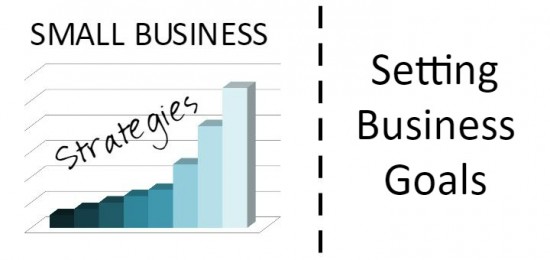Welcome back to January's edition of Small Business Strategies! This month we're taking a look at how to set goals for your business - as it's the start of the new year, January is the perfect opportunity to take the time to review your business and see what direction you want to head in the next twelve months. Joining me this month is Aleesa McCarthy of SaongJai Jewelry, a Catholic-based business she runs with her sister.
![]()

IMPORTANCE OF SETTING GOALS
A new year means a new start. It’s a great time to recognize both the wins and loses from the previous year, and to set goals for the new year.
Why set goals? Setting a goal lets you not only measure success but ensure you’re focusing and moving in the right direction. Without goals, business tend to chase the proverbial shiny paper – as in, “Oh, that looks like a good idea! I’m going to do that!” when itcomes to new products or changes in product lines, or “I need to make more products…I should hire someone” when things get busy. Changes are less proactive and more reactive. Having goals that let you set direction – while still maintaining a sense of flexibility within the business to modify goals if needed – ensures that you (and your team) have a vision of what the business will accomplish over the next 12 months, know what cohesive goal you’re working towards and enable you to plan appropriately for those goals, and adjust as needed to meet your goals throughout the year.
HOW TO SET GOALS
When small business owners think of goals, the first though is often financial. Whether it be a goal of staying out of the red, or hitting a specific sales target, goals are often tied to a monetary target. While financial goals are good to have – and should be included in the list of goals for a business – they shouldn’t be an end unto themselves.
- STEP 1 – brainstorm your goals: Think first of what you want to accomplish in the next year. Do you want to create a brand for your business? Streamline a production process? Grow your team? Introduce a new product or product line? Write down everything you want your business to do, regardless of how much work or how long you think it will take you. This is all about brain-storming. Aleesa focuses on her customers during her brainstorming session: "I take time to sit down and think about what I like to have and what other's might want to purchase. Then I look for supplies, research a price point for the item, and do the math to see if it pencils out. A goal I had the year before was to have more orders: in 2014 the shop had 40 orders and by sitting down and making plans that I actually followed through with turned 2015 into a year that gave us 125 shop orders and tripled our revenue."
- STEP 2 – long-term vs. short-term goals: Once you’ve written down your goals, look at each goal and jot down how long it will take you to reach that goal. For example, if your goal is to teach a class at a local knitting store but you’re still working on mastering certain techniques, set this as a long-term (3-5yr) goal. If your goal is to create a logo as part of a brand, set this as a short-term (1-3yr) goal.Aleesa agrees on the importance of setting goals: "Goals are so impo
 rtant! Like a lot of creative people out there who just want to make things, I am not the type that immediately thinks about setting goals. But it is an invaluable habit to hone. Thankfully, I have an amazing hubby who has pushed me to set goals for myself and I am so grateful. This year I sold over 25 rosary hangers in our shop and that was an improvement over the 6 that were sold the year before (since they were kind of popular I put in the time to find a way to make them faster which enabled me to make more this year)! "
rtant! Like a lot of creative people out there who just want to make things, I am not the type that immediately thinks about setting goals. But it is an invaluable habit to hone. Thankfully, I have an amazing hubby who has pushed me to set goals for myself and I am so grateful. This year I sold over 25 rosary hangers in our shop and that was an improvement over the 6 that were sold the year before (since they were kind of popular I put in the time to find a way to make them faster which enabled me to make more this year)! " - STEP 3 – categorize goals: Further break your goals down by categorizing them. You may find that several goals tie into each other; for example, you may have written down to (a) create a new logo, (b) standardize your fonts on your website, and (c) design business cards. These can all be categorized as “build a brand.” Grouping your goals together will help you see trends in your goals, as well as help you to use your time most efficiently when working to meet your goals. "I have found that keeping goals organized is important," Aleesa adds. "There is the great temptation to run off with what you may think are brilliant ideas but if they don't benefit your goals this might end up hurting in the end. Spreading yourself too thin or making impulsive decisions when you see that supply sale and think oh, I can do this that or the other thing and make it worth the purchase, if not thoughtfully planned has left me wishing I had stayed in my green pasture of goals."
- STEP 4 – make your goals S.M.A.R.T.: Now that you have your goals grouped by category and time, it’s time to create actionable steps to help you attain your goals. A common acronym for this process is S.M.A.R.T.
- S: ensure that the goal itself is specific. For example, one of my original goals for Faith and Fabric is to “get published in a magazine”. A better way to say this – more specifically – is “have a Christmas quilt pattern published in X, Y, or Z magazine.” Making a goal more specific helps to better define what it is you’re trying to achieve.
- M: make the goal measurable. You may have a goal of “increase how much money I make”. This isn’t necessarily a measurable goal, though. For example, if your profit increases, but your expenses do, too, does this count as increasing how much you made? Is this what you meant when you set the goal? A better way to say this: “Increase net profit by 30%.” This is a specific target you can measure your success against.
- A: create action-oriented steps. A goal without clear steps on how to get there is unlikely to be met. Take a look at your goal, and write out what steps need to be taken in order to meet that goal. Assign who is responsible for each step – even if it’s you.
- R: be realistic. As you work through your goals, give each a sanity check. Are the goals you set realistic/feasible? Do you have the ability, time, etc. to meet each goal? If not, set that goal aside for now.
- T: assign a timeline. Much like prioritizing, set a timeline for your goals. Some goals will take longer to achieve than others, so figure out which you can simultaneously work on, which require your full attention, and any inter-dependencies between the goals themselves. Having business goals to work towards will help keep your small business on track and give you the direction you need to make 2016 your best year yet!
Copyright 2016 Jen Frost
About the Author

Jen Frost
Jen Frost is a Catholic quilter and crafter who evangelizes through fabric! She’s a pattern writer, quilt designer, and book author about liturgical living in the home. She loves Instagram, and writes and quilts each week at Faith and Fabric. Subscribe to the newsletter to join the fun, as well as receive great sewing tips and discounts, each month!


.png?width=1806&height=731&name=CatholicMom_hcfm_logo1_pos_871c_2728c%20(002).png)
Comments